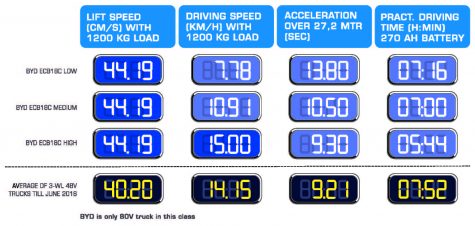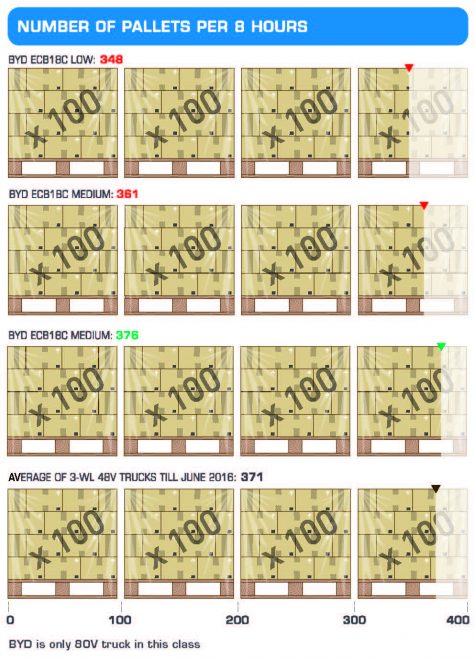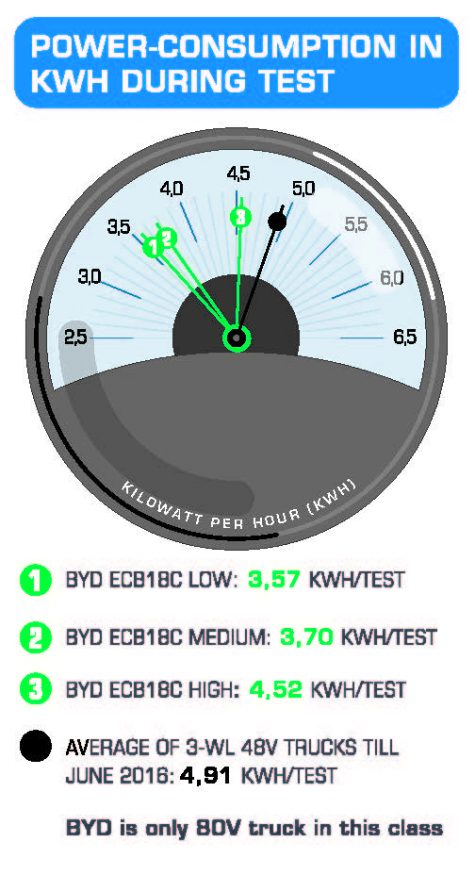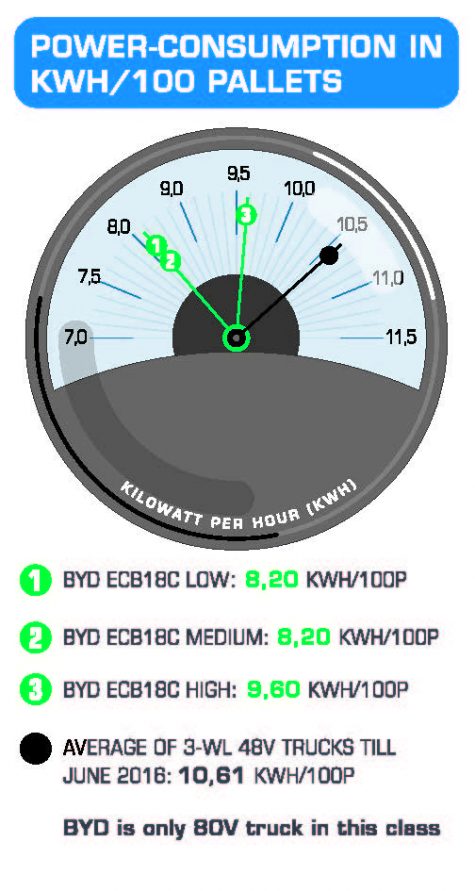The 1.6 and 1.8-ton electric three-wheel forklift trucks from BYD (Build Your Dreams) are just like their larger counterparts equipped with an 80V system. This gives them unprecedented power, but they are remarkably economical and manageable. Along with the maintenance-free lithium iron phosphate battery they set the standard for a whole new way of truck use.
BYD surprised everyone in 2015 with the official introduction of its new line of forklifts with 1.5 to 3.5-ton lifting capacity. Developed and built in China, they fully comply with the recommendations of the European market too. The trucks are better finished than the average Chinese truck we have tested before and also perform better.
 The most notable feature of this truck, is hidden under the battery cover. There resides a 80 volt lithium iron phosphate battery that BYD itself produces. Because of uniformity and ease of production, range, however the manufacturer also installs this battery in its compact trucks, such as the 1.6 and 1.8 compact trucks in this test. This makes BYD the first manufacturer in the world to equip small, compact three-wheel forklift trucks with lithium technology.
The most notable feature of this truck, is hidden under the battery cover. There resides a 80 volt lithium iron phosphate battery that BYD itself produces. Because of uniformity and ease of production, range, however the manufacturer also installs this battery in its compact trucks, such as the 1.6 and 1.8 compact trucks in this test. This makes BYD the first manufacturer in the world to equip small, compact three-wheel forklift trucks with lithium technology.
The advantages of the lithium iron phosphate battery are numerous. It is maintenance free and it does not produce any gases while charging, so you can charge it anywhere. You do not need a battery switch station with all the necessary safety features and in principle you do not have to change it. BYD also claims that its technology is much safer than other lithium systems and pro ves that with a number of documented certified tests in which the battery is severely abused – by deliberately setting it on fire, keeping it under water and by completely crushing it – without causing a dangerous short circuit.
ves that with a number of documented certified tests in which the battery is severely abused – by deliberately setting it on fire, keeping it under water and by completely crushing it – without causing a dangerous short circuit.
To be honest this battery also has some disadvantages. For instance the capacity is limited compared to traditional lead acid batteries, but that’s okay. You can recharge the BYD battery at any given time and as often as wanted or needed, without capacity loss. It takes just an hour to charge a completely empty battery, and partially reloading during a 15-minute coffee break or half-hour lunch break makes a half-empty battery nearly full again. The manufacturer BYD gives a written guarantee of maintaining the maximum number of cycles for more than 10 years, even if you recharge the battery partially several times a day.
If you have lot of work to do using the trucks and perhaps even have to work double shifts, it is important to learn a different way of working with the BYD concept of charging at every break. BYD has made this easy by including a plug-in for the battery charger through a panel at the side of the truck. Just plug in and charge only. But does that really work? Yes! We recharged the half-empty battery on the test truck to completely full in just 29 minutes, and that is more than enough to complete the rest of a shift and start the next one. This approach calls for a different arrangement of the battery chargers and their location; preferably close to or en route to the canteen.
Quick charging is one thing, but what about performance? The answer is clear: excellent! This goes for both lifting and driving speeds. The cabin is spacious, even on this compact three-wheel truck. The mast functions are properly metered and the mast itself is rigid enough without excessive backlash or torsion. The finish of the truck is neat and the overall construction is robust. Only the cabin profiles could be a bit slimmer. They somewhat block the view for the driver.
BYD provides its trucks with several standard or comfort components. The standard version is equipped with mechanical hydraulic levers and a basic seat that can easily be replaced by a better one, such as by a more luxurious Grammer MSG65 with adjustable armrest and electric/hydraulic fingertip levers. These levers are unique because they have a tactile stop at 1/3 and 2/3 of the stroke. For example, it is even easier to precisely control the mast movements. The control console armrest also houses the travel direction switch that is controlled easily by the thumb.
The seating position behind the steering wheel is good and the steering column is steplessly adjustable. The dashboard is equipped with a remarkably clear colour display (also manufactured by BYD itself). The display shows all the necessary information about the truck, the selected mode H, M or L (high, medium, low), the mileage, the battery charge status and driving direction. Unfortunately the steering wheel position indicator is missing; this feature is always handy while driving a three-wheel forklift truck because the rear steering wheel is not visible from the driver’s seat.
The 1.6 & 1.8 BYD trucks are completely identical, only the counterweight of the 1.8 is slightly larger. It is striking that both trucks feel somewhat restless as you drive without a fork load. We suspected that this was due to the Chinese-standard solid rubber tyres and that does indeed turn out to be the case. To be sure, we fitted a set of the Trelleborg brand during the test. With them, the trucks drove smoother and more predictably, and the restless behaviour completely disappeared.
During the performance measurements both models scored slightly higher productivity than the average in this class. Energy consumption is significantly better than  average. The 1.6-ton model scored an uptime of nearly 6 hours (in H mode) and over 6 hours (in M mode). With the heavier 1.8-ton version the energy consumption is logically slightly higher and we scored somewhere between 5 and almost 6 hours in H and M mode. That seems rather short, but what do you expect with a battery capacity of only 230 Ah? If you choose the optional maximum 270 Ah battery, you can easily add an hour. And when you use the coffee and lunch breaks for recharging, you can easily perform for a whole day.
average. The 1.6-ton model scored an uptime of nearly 6 hours (in H mode) and over 6 hours (in M mode). With the heavier 1.8-ton version the energy consumption is logically slightly higher and we scored somewhere between 5 and almost 6 hours in H and M mode. That seems rather short, but what do you expect with a battery capacity of only 230 Ah? If you choose the optional maximum 270 Ah battery, you can easily add an hour. And when you use the coffee and lunch breaks for recharging, you can easily perform for a whole day.
All in all, the compact BYD forklift trucks are a true revelation. They drive well (especially when fitted with quality tyres), performing above average and are quite economical in terms of energy consumption. Some features still have room for improvement. In our view the rather high step into the cabin, lack of storage space and the old-fashioned lever parking brake could be updated. However it performed well by keeping the truck steadily in place. It is also clear that the BYD trucks will not win a prestigious design award or score in terms of highly sophisticated safety techniques. Perhaps BYD can win a trophy when it comes to the sum of innovations that focuses on customer benefit, usability and durability. The 1.8-ton truck is also a serious candidate for the IFOY Award 2016. In particular, the lithium iron phosphate battery technology and totally carefree use of the engine is a big plus. Watch out for these ‘blue rascals’ in the near future.
Pluspoints:
For improvement:
Tags:
Andersom test, BYD, BYD ECB 16C, BYD ECB 18C, Forklift test, Test
Basic instinct With the RCE line, STILL expands its...

Simply good With the EJE M15 Jungheinrich offers an ec...

Functional and complete Clark recently introduced its ...